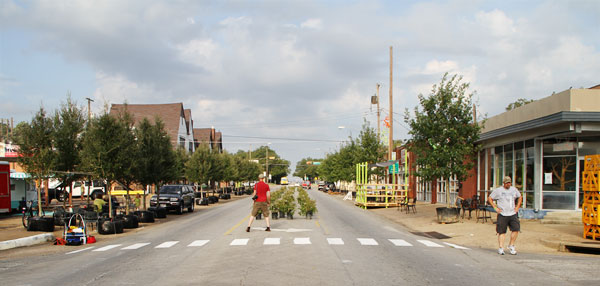Dallas has a reputation for being big and brassy. Jerry Jones built the world’s largest sports bar here (to borrow a line from Frank Deford and with apologies to those arrivistes in Arlington). We made the Chevy Suburban here (again, sorry, Arlington). Exxon Mobil runs its operations from here (yes, we know, Irving). “Calatrava? We’ll take two!” That sort of thing. But what if I told you that the coolest, smallest, greenest idea in urban planning came out of Dallas? And what if I told you it’s making waves nationally?
It all started as a bicycle club. A group of thirtysomethings—mostly young professionals and recent homebuyers in North Oak Cliff—grew tired of cars driving as if they owned the road, making life miserable for all but the most courageous of riders. So they broke the law.
On an unattractive one-block stretch of Davis Street, where restaurants struggled amid boarded-up early-20th-century brick buildings, the merry cyclists painted their own bike lanes on the street. And they didn’t stop there. The group, led by a guy named Jason Roberts, did an extreme street makeover for just a single weekend day.
To a dormant telephone pole they attached a painted tricycle, a child’s bike, and a full-size model, so that they looked like they were riding to the sky (a cheaper version of the Nasher’s Borofsky sculpture). They transformed the appropriately named “suicide lane”—the shared center turning lane—into a landscaped median with potted shrubs, which replaced hot asphalt littered with broken glass. They talked a landscaping company into loaning them 42 15-foot-tall oak saplings. They placed the trees along the curb so that their canopy provided a cooling shade over colorfully painted tables and chairs that sat along the length of the block, where cars normally parked. Cars still had their place, but people now outnumbered them. Drivers slowed to a crawl as they entered the block, fascinated by the goings-on, their journey made more enjoyable and delayed not more than a minute. The outdoor cafe seating almost drew more customers than the restaurants could serve. Roberts and his crew painted new Abbey Road-style crosswalks and installed bike racks to handle the influx. Temporary businesses—a fruit stand, an art gallery, a beer garden—sprung up in the unused storefronts.
The one-block, one-day makeover was called the Better Block Project. It demonstrated that a street is more than just pavement. It turned a beleaguered stretch of Davis Street into a lively, safe, colorful public square, something that felt like home.
The roots of the Better Block Project trace back to Jan Gehl’s transformative work in Copenhagen in the 1960s, when that city incrementally removed traffic from its car-choked medieval streets and replaced it with pedestrian space. Today, Copenhagen is one of the most livable and prosperous cities in the world. More recently, New York City hired a woman named Janette Sadik-Khan as its transportation commissioner. She overhauled that city’s streets literally overnight with a couple of cans of paint and some traffic cones, creating new bike lanes and plazas. What differentiates the Better Block Project, though, is that it’s not official public policy. It’s guerrilla DIY urbanism.
And now, thanks to BetterBlock.org (which I’ve contributed to), Roberts and his crew have spurred similar citizen-led street improvements in Deep Ellum and Fort Worth. The Washington Post wrote about a Maryland woman’s efforts to replicate the project. Even Billy Joel, inspired by YouTube videos shot in Oak Cliff, underwrote a Better Block Project in his hometown of Oyster Bay, New York.
Once upon a time, when intercity economies required improved connections between them, building roads led to economic development. Today, we suffer from systemic overshoot, too afraid to shut off that faucet of state and federal money, bankrupting public coffers, polluting the air, wreaking havoc on the real estate system.
The Better Block Project represents a community-based remedy. Its beauty lies not in rebellious artistic expression but rather in its economic benefits. Cliff Notes, the Oak Cliff bookstore, reported its best day ever during a Better Block Project. Similarly, Panther City Bicycles on Magnolia Avenue in Fort Worth said its sales rose 80 percent. Where people gather and create a good vibe, investment will follow. Once the investment occurs and the tax base rises, expenditures for permanent alterations to the street become possible.
Local governments should dump the conventional wisdom that bigger, faster roads bring progress. They should adopt the Better Block concept of “road bettering.” Otherwise, it’s like running a 21st-century economy on a 14.4K modem.
Write to [email protected].






